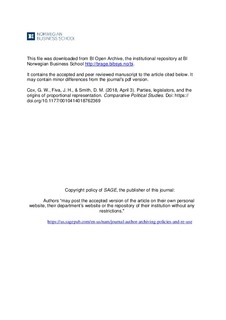Parties, Legislators, and the Origins of Proportional Representation
Journal article, Peer reviewed
Submitted version
Permanent lenke
http://hdl.handle.net/11250/2571810Utgivelsesdato
2018Metadata
Vis full innførselSamlinger
- Publikasjoner fra CRIStin - BI [1015]
- Scientific articles [2181]
Originalversjon
Comparative Political Studies, 2018 April 3. https://doi.org/10.1177/0010414018762369Sammendrag
A prominent line of theories holds that proportional representation (PR) was introduced in many European democracies by a fragmented bloc of conservative parties seeking to preserve their legislative seat shares after franchise extension and industrialization increased the vote base of socialist parties. In contrast to this “seat-maximization” account, we focus on how PR affected party leaders’ control over nominations, thereby enabling them to discipline their followers and build more cohesive parties. We explore this “party-building” account in the case of Norway, using roll call data from six reform proposals in 1919. We show that leaders were more likely to vote in favor of PR than rank-and-file members, even controlling for the parties’ expected seat payoffs and the district-level socialist electoral threat facing individual legislators. Moreover, using within-legislator variation, we show that the internal cohesion of parties increased significantly after the introduction of PR
